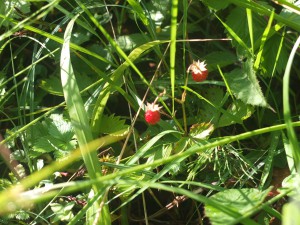Maybe you are familiar with this classic Buddhist story, often used as an example of mindfulness.
“Once there was a Buddhist monk who practiced his meditation by walking in the forest each morning. One clear crisp morning, the monk heard a rustling in the leaves and looked up to see a large tiger watching him from a distance. Sensing that the tiger was about to attack, the monk started running as fast as he could, only to come to a clearing and a high cliff. Not seeing any other way to go, the monk grasped a large vine running partly down the side of the cliff, and began to climb down it just as the tiger arrived. So there the monk was hanging, grasping the narrow end of a vine, with a snarling tiger above him, and a long deadly fall beneath him. To make matters worse, a mouse appeared and began to gnaw on the vine just above him, but out of his reach. Just then, the monk noticed a wild strawberry plant growing from the side of the cliff with one small red strawberry on it. He reached out, picked the berry, put it in his mouth and thought to himself, “this strawberry is delicious!”.
Some people got interested in Buddhism, and others in tigers or in mindfulness.
But I got interested in the strawberry. What kind of strawberry could cause the monk to take it, taste it and to prefer that over trying to help himself?
I know of only one kind strawberry that is worth doing that and it’s this one. It’s not the ordinary one we eat most of the time, the table tennis ball size Fragaria ananassa, but rather the tiny Fragaria vesca or alpina or in French: Fraises des bois. I won’t bore you with the botanical discussion about their name.

This small alpine strawberry, which I found in Switzerland, has a problem though: once you have tasted these, freshly picked, it will be hard to appreciate the taste of the ordinary strawberry, in our country mostly grown in glasshouses, full of water, and lacking taste. The taste is extremely aromatic, delicious, ambrosial, almost artificial, comparable to the taste of cheap fruit chewing gum.
At least now you know why the monk did what he did, so the lesson is you don’t need meditation or mindfulness, just buy, or better grow, eat and enjoy the blissful Fragaria vesca alpine. It saves time and tastes better too.
Needless to say that strawberries, any kind, are healthy too, probably due to its content of ellagic acid, anthocyanins and other polyphenols.
Literature:
Van de Velde, F; Tarola, A.M; Guemes, D; Pirovani, M.E: Bioactive Compounds and Antioxidant Capacity of Camarosa and Selva Strawberries (Fragaria x ananassa Duch.); Foods, Vol.2, 2013, pg.120-131.
Giampieri, F; Alvarez-Suarez, J.M; Battino, M: Strawberry and Human Health: Effects beyond Antioxidant Activity; J. Agricult. Food Chem.2014.
Giampieri, F; Alvarez-Suarez, J.M ; et.al: The potential impact of strawberry on human health; Natural Product Research, 2012, pg.1-8.
Zhang, H.M; Zhao, L et.al.: Research progress on the anticarcinogenic actions and mechanisms of ellagic acid; Cancer Biol Med Vol.11, 2014, Vol.11, pg. 92-100.
And if you think that research on the taste of strawberries cannot be serious, read this article:
Schwieterman, M.L; Colquhoun, T.A; Jaworski, E.A: Strawberry Flavor: Diverse Chemical Compositions, a Seasonal Influence, and Effects on Sensory Perception; PLOS One; Vol.9, Issue 2, February 2014, e88446, pg.1-12.
